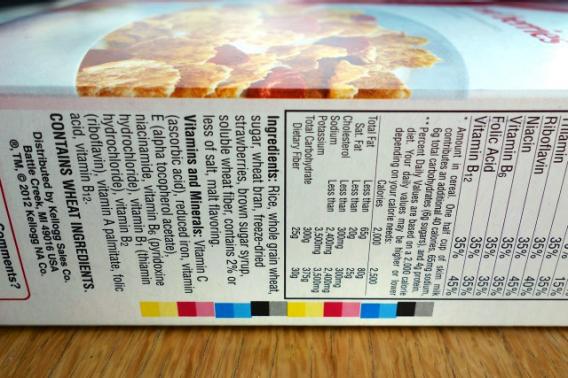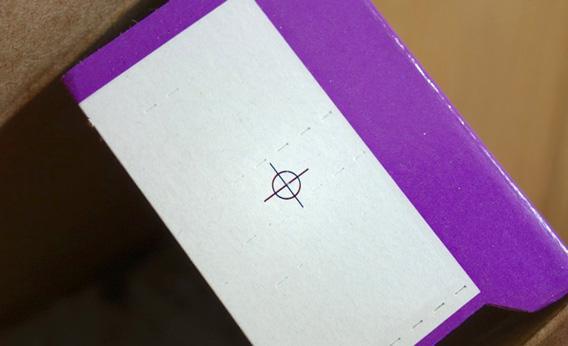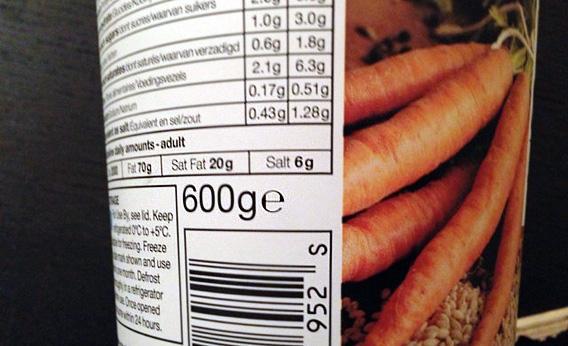What Do The Colors On Packages Mean
What's That Thing? Puzzling Packaging Edition

Mark R. Jones.
Our latest effort to dispel the mysteries of the mod visual landscape finds usa in the supermarket. For previous columns, click here; to submit your own suggestions, electronic mail u.s.a..
There are lots of skilful reasons to have a closer wait at food packaging. You might be trying to lose weight or to eat more healthily (the start and fourth most normally broken New year's resolutions, obviously). You might wish to avoid eating "anything with more than than five ingredients, or ingredients you can't pronounce," as Michael Pollan has suggested. You might be scouring food packages—in vain, and so far—for Mark Bittman's dream food label. Or maybe you just want to check that your Twinkies—which may or may not be graced with eternal life—are still fresh.
But whatever draws your gaze to the nether regions of your cereal box or yogurt carton, go on your eye out for a color pattern similar the ane in the image in a higher place. Needless to say, every millimeter of existent manor on food packaging is valuable. Then what's so of import about these color patterns that they should be included? Equally always, four guesses:
a) The pattern is called a chromatic bar code (CBC). In many countries, supermarket scanners use color bar codes, which tin can be read more than reliably than the blackness-and-white sort we use in the U.S. Products sold with the same packaging in the U.S. and these countries will accept both a CBC and a blackness-and-white bar code.
b) The blobs of colors are known as printer's colour blocks or procedure command patches. They're used to help control the quality of individual colors used by a printer, so that the tints and hues are correct and consistent.
c) The pattern is called a printed catch cake. In automatic packing systems, which use machines to package your food, the grab block makes it easier for such machines to correctly maneuver and align the packaging as information technology is manufactured and shipped.
d) It's called a printed heat date (PHD). The ink used for the brighter colors fades over time. When there'southward no difference between the bright and faded colors, then supermarkets will generally consider the food to exist expired, regardless of the printed expiration date.
And the correct answer is…
… b). Process control patches, or printer'southward color blocks, are used to cheque the quality or density of colors that are used on the package. According to Bridget Christenson, PR managing director for General Mills:
The color blocks are essentially a tool used to sympathize how a printer is printing at any moment in time to ensure consistency. The blocks provide very technical data well-nigh printing conditions that let printers to quickly accommodate. For example, if something looks too cerise, the color blocks can help to determine if it's the Yellow that is too weak or if it's the Magenta that is too heavy. This keeps press quality high.
Both man and machine usually bank check these color splotches. According to Dillon Mooney, technical consultant for Press Industries of America, "Modern presses accept automated the process, only the operator typically makes the final adjustments." The colors that announced most frequently are the "process colors" black, cyan, magenta, and yellowish. As my diabolical Hewlett Packard printer has on rare occasions proven, these colors can be combined into many other colors.
Merely what near the package of Cheetos I but ate—take that, Pollan—which features not merely the four process colors but besides a range of subtle, discriminating orange hues? These are known as spot colors, which are "premixed for consistency," according to Mooney. The orange on Cheetos' packaging is a naturally big part of the brand'due south image, and so it'south applied as its own color. (Is this same ink used to colour the actual Cheetos? Probably non, though I don't know for sure.)
Why practice some packages non have any color patches? It's merely a printer/client preference, says Christenson. But keep in mind that colors might have been on a printed portion of the parcel that was later trimmed off.
While puzzling over these packaging perplexities, I decided to look into a few more. First, the "U" in a circle, followed past a "D," which you can see here courtesy of Pepperidge Subcontract Genevas (though cookie-wise I'm more a human being from Nantucket…). "OU" stands for Orthodox Matrimony, a Kosher certification. The "D" that follows indicates that the product contains dairy. You can find total descriptions of various Kosher certification marks—and the individual messages that may follow them—online. There are also Halal marks, though in America these are much less common.

Marking R. Jones.
What about the ominous cross-hairs that occasionally appear on packaging, seen here on a cereal box's inside flap? These "are annals marks, also chosen crossmarks or position marks," says Christenson. They "help make certain the colors are aligned."

Marking R. Jones.
Finally, permit'due south expect at the "east" that is found on most food packaging in the fabled, genetically-unmodified lands of Europe (and on many European products exported to the U.South.) If you have no thought what it ways, don't feel bad—neither do most Europeans. In an breezy survey of about two dozen European friends and family, none had ever noticed this symbol, or had whatever thought what it meant. Asked to judge, they wondered if it meant that the number reflected the weight of the contents without the container included, or if information technology denoted something eco-friendly, or if information technology maybe indicated that a product was legal for sale beyond the European Union.

Mark R. Jones.
In fact, the due east signifies that the product complies with European union regulations on the accuracy of the weight or volume measurement on the package. So if a canteen says "500ml e," then you know that the Eu approves of how that 500ml claim is calculated. Also known as an e-marker or "estimated sign," the e isn't mandatory, but information technology acts equally a "metrological passport" proving that a package more or less contains the quantity it claims.
Of course, even the most Europhilic American might wonder about the usefulness of a symbol that 1) appears on virtually everything in a supermarket and ii) is a complete mystery to virtually all consumers. Reading the relevant European Directives on the eastward-mark will not, I assure you, make such wondering cease.
If you find yourself wondering about something in the cookie section of a Helsinki supermarket, or anywhere else, take a pic and send it along.
Previously in What's That Thing?
City Steam
Lump on a Wire
Convenience Store Strips
Wall Socket Buttons
Lift Southward Button
Pastoral Doodad
Ominous Gizmo
Dashboard Arrow
Mysterious Wires
What Do The Colors On Packages Mean,
Source: https://slate.com/culture/2013/01/color-spots-on-packages-what-are-those-things.html
Posted by: hobbsnevered1981.blogspot.com


0 Response to "What Do The Colors On Packages Mean"
Post a Comment